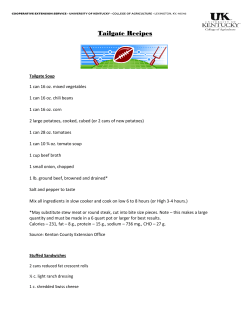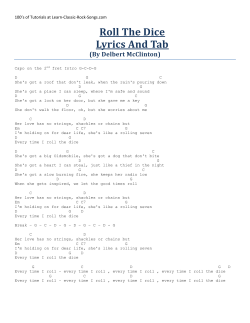
Backgammon Quiz
with your Hostess Jenny Quinn and Backgammon Expert Art Benjamin Rules of Participation Individual participation (no teams please) There are 10 questions, some are multiple choice, some are short answer. ± Label each question and clearly write your answer. ± Exchange sheet with neighbors for grading. ± Reveal and explain the answers. Top scorers will roll-‐off for the grand prize of $200. Question 1 What is the minimum distance that all of the white checkers have to move to be off the board? Give a numerical answer. Question 2 A. tŚŝĐŚŽĨǁŚŝƚĞ͛Ɛbearoff positions is most likely to be off in one roll? 61 52 43 B. tŚŝĐŚŽĨǁŚŝƚĞ͛Ɛbearoff positions is least likely to be off in one roll? Question 3 How many ways can 15 identical checkers be allocated among 6 points? Some of the points are allowed to be empty. 15 a) 6 b) 615 /15! 21· § c) ¨ ¸ ©6¹ § 20 · d) ¨ ¸ ©5¹ 20 · § e) ¨ 14 ¸ © ¹ Question 4 In backgammon, what is the average number of pips per roll? Remember that doubles count twice: 4 pips with double 1s, 8 pips with double 2s, 24 pips with double 6s. Question 5 A. For the given board, should white double? B. If white doubles, should black take? Question 6 A. For the given board, should white double? B. If white doubles, should black take? Question 7 tŚĂƚĂƌĞǁŚŝƚĞ͛ƐĐŚĂŶĐĞƐŽĨǁŝŶŶŝŶŐ͍ Question 8 On average, how many rolls does it take for white to enter his checker? Question 9 What is the probability that white takes 4 or more rolls to get in? Question 10 How should white play the roll 2-‐1 to maximize the chance of getting off of the gammon? Ready or Review? Question 1, 2, 3, 4, 5, 6, 7, 8, 9, or 10? /ĨŶŽŵŽƌĞƋƵĞƐƚŝŽŶƐ͙͘͘ exchange with a neighbor (Make sure your name is on your paper!) Question 1 Each checker on the 6 point travels 6 pips. Each on the 8 point travels 8 pips, and so on. What is the minimum distance that all of the white checkers have to move to be off the board? Give a numerical answer. 167 pips (1 point) Question 2 A. tŚŝĐŚŽĨǁŚŝƚĞ͛Ɛbearoff positions is most likely to be off in one roll? 19 rolls 15 rolls B: 61 least (1 point) A: 52 17 rolls 43 most (1 point) B. tŚŝĐŚŽĨǁŚŝƚĞ͛Ɛbearoff positions is least likely to be off in one roll? Question 3 How many ways can 15 identical checkers be allocated among 6 points? Some of the points are allowed to be empty. 15 a) 6 b) 615 /15! 21· § c) ¨ ¸ ©6¹ § 20 · d) ¨ ¸ ©5¹ 20 · § e) ¨ 14 ¸ © ¹ (1 point) Question 4 In backgammon, what is the average number of pips per roll? Remember that doubles count Answer: 8 1/6 twice: If you ignore doubles, the 4 pips with double 1s, average role is 7. But 1/6th of 8 pips with double 2s, the time, because of rolling 24 pips with double 6s. doubles, you get an additional 7. (1 point) Question 5 A. For the given board, should white double? B. If white doubles, should black take? Probability that white wins is 19/36. A. Yes (1 point) B. Yes (1 point) Question 6 A. For the given board, should white double? B. If white doubles, should black take? A. No (1 point) B. Yes (1 point) Question 7 tŚĂƚĂƌĞǁŚŝƚĞ͛ƐĐŚĂŶĐĞƐŽĨǁŝŶŶŝŶŐ͍ 86/216 (1 point) Black wins with probability (5/6)(26/36) = 130/216, So white wins with probability 86/216. Question 8 On average, how many rolls does it take for white to enter his checker? 1.8 rolls (1 point) Since white enters with probability 5/9, it takes on average 9/5 = 1.8 rolls, on average. Question 9 What is the probability that white takes 4 or more rolls to get in? 64/729 (1 point) /ƚ͛ƐƚŚĞĐŚĂŶĐĞƚŚĂƚ white fails to get in at least 3 times, which is (4/9)3 = 64/729. Question 10 How should white play the roll 2-‐1 to maximize the chance of getting off of the gammon? Move 12 to 10 then 5 to 4. (1 point) This allows white to get off gammon with rolls 66, 55, and 44. Lucky 13 Anyone? 12 11 10 9 8 7 6 Roll off In backgammon it is sometimes better to be lucky than skillful. Thanks to especially Gerard Venema
© Copyright 2025










